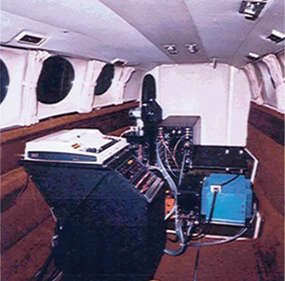Publications
Lab Notes
| LOOKING BACK | Posted September 2008 |
|
Conceiving Collision Avoidance When Congress held hearings in June 1979 on how to prevent midair aircraft collisions, the Federal Aviation Administration (FAA) indicated that transponder-based surveillance was not technically feasible. At that time, Lincoln Laboratory was completing a new FAA air traffic control surveillance system designed to replace old technology. We understood transponder surveillance, and we took that testimony as a call to action. A DC-9 collision with a Marine jet in California in 1971, which killed 50 people, had heightened the urgency for a collision-avoidance system using air-to-air surveillance. Airline prototypes with top-mounted antennas to minimize terrain multipath interference effects, new frequencies to avoid interference, and modern waveforms for timing accuracy worked, but were impractical because all existing planes would need expensive new equipment before the new system could detect them.
|
||
Around this time, airlines were asking whether they could use the civil versions of World War II-type transponders that many aircraft still carried for air-to-air surveillance. This approach had major technical problems. Although ground interrogators used narrow antenna patterns to limit interference, replies from multiple transponders interfered with one another in densely traveled airspace. This garbling would increase if planes also began interrogating. In particular, they couldn’t use directional antennas, which would be too big for an aircraft. Furthermore, existing transponder antennas were bottom-mounted, and they would see strong multipath reflections from the ground in air-to-air transmissions.
In 1975, Walter Wells, leader of Lincoln Laboratory’s air traffic control group, asked me to study this problem. I had already found large variations in commercial transponders’ ability to decode interrogations, and I proposed to reduce garble by varying the interrogation pulse width. Using a built-in transponder suppression mechanism, we would transmit a series of alternating suppressions and interrogations with gradually increasing pulse widths, thereby dividing the transponders into reply subpopulations.
Researchers at MITRE Corporation had also tackled the garble problem and proposed to discriminate between transponders by transmitting gradually increasing power to exploit variations in their sensitivity. This approach had some clear advantages. Aircraft orientation and airframe shielding cause independent variations in effective antenna gain that increase the effective transponder variance and help separate otherwise identical transponders. William Harman saw another important benefit: variable interrogation power would help filter out lower-power multipath reflections by causing transponders to reply only to interrogations near receiver threshold.
We encouraged the FAA to test this idea. In flight trials, the interrogation power was varied with an RF attenuator that used a power diode with a digitally controlled bias voltage. But Laboratory engineers Ray LaFrey and Joe DiBartolo realized that such an attenuator would never be stable enough for the job. Indeed, problems with the attenuator’s resolution, instability, and speed caused the trials to fail—hence the pessimistic report to Congress.
That failure inspired Ray and Joe to develop a better attenuator. In 1980, DiBartolo worked with a commercial vendor to build a more stable unit that replaced the diode with an array of switched attenuators. With Dave Spencer, Dennis Callahan, and Bill Petrovick, they built a prototype that we could fly. Harman and Loren Wood used it over the next several years to refine the algorithms for tracking replies in the face of multipath and garble. The result was the Traffic Alert and Collision Avoidance System (TCAS), which has had remarkable success in preventing mid-air collisions.
—Jerry D. Welch
Welch, a senior staff member at Lincoln Laboratory, led the Laboratory’s program to develop TCAS.
top of page
